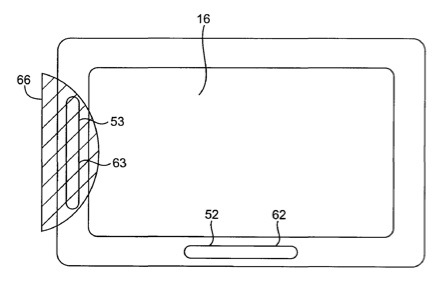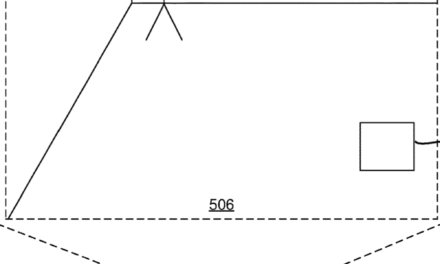Apple has been granted a patent (number 8159399) for antenna diversity systems for portable electronic devices — namely, iOS devices such as the iPhone and iPad.
Per the patent, antenna diversity systems are provided for portable electronic devices that have wireless communications circuitry and environment sensors. The wireless communications circuitry may include multiple redundant antennas that operate in one or more overlapping radio-frequency communications bands. The environment sensors and redundant antennas may be used in implementing an antenna diversity system.
For example, an electronic device may use environment sensors to select an antenna for use in handling wireless communications. The electronic devices may monitor the wireless performance of an active antenna. When the wireless performance of the active antenna degrades, the electronic devices may select a new antenna for wireless communications using the antenna diversity system and environment sensors. Antenna selection may also be made based on which features are being used in the electronic device.
Here’s Apple’s background and summary of the invention: “Portable electronic devices such as handheld electronic devices are becoming increasingly popular. Examples of handheld devices include handheld computers, cellular telephones, media players, and hybrid devices that include the functionality of multiple devices of this type. Popular portable electronic devices that are somewhat larger than traditional handheld electronic devices include laptop computers and tablet computers.
Due in part to their mobile nature, portable electronic devices are often provided with wireless communications capabilities. For example, portable electronic devices may use long-range wireless communications to communicate with wireless base stations. Cellular telephones and other devices with cellular capabilities may communicate using cellular telephone bands at 850 MHz, 900 MHz, 1800 MHz, and 1900 MHz. Portable electronic devices may also use short-range wireless communications links. For example, portable electronic devices may communicate using the Wi-Fi (IEEE 802.11) bands at 2.4 GHz and 5.0 GHz and the Bluetooth® band at 2.4 GHz. Data communications are also possible at 2100 MHz and the unlicensed 60 GHz band (57-66 GHz).
“A number of compromises are typically made when designing antennas for a portable electronic device. For example, antennas that protrude excessively from a device housing may be unsightly. Antennas that are located within a device housing may be more desirable from an esthetic point of view, but can be challenging to design. Internal antennas are sometimes subject to proximity effects that make antenna performance dependent on the position of objects (such as a user’s body) relative to the antenna.
“Electronic devices that have redundant antennas (e.g., two or more antennas that operate in similar radio-frequency bands) may use diversity schemes to improve the reliability and performance of wireless communications activities. Traditional diversity schemes involve monitoring the strength or quality of signals that are received from multiple antennas in real time. If an antenna’s performance drops below a given threshold, another antenna may be used for wireless communications activities. Antenna diversity schemes of this type may offer superior performance to arrangements that rely solely on a single antenna.
“However, waiting for antenna performance to degrade before making antenna adjustments can lead to undesirable dropped signals. It would therefore be desirable to be able to provide improved antenna diversity systems.
“Antenna diversity systems are provided for portable electronic devices. The antenna diversity systems may use proximity sensors or other environment sensors to improve the wireless communications performance of portable electronic devices that operate in rapidly changing environments. The portable electronic devices may have wireless communications circuitry that includes transceiver circuitry, two or more antennas that operate in identical or similar radio-frequency communications bands, and circuitry for coupling a desired one of the antennas to the transceiver circuitry. The environment sensors may include any suitable sensors such as proximity sensors, ambient light sensors, accelerometers or other orientation sensors, touch sensors, thermal sensors, combinations of such sensors, etc.
“The antenna diversity systems may use information from environment sensors and information from application software to determine which of the antennas is most likely to have satisfactory performance for wireless communications activities. For example, in an electronic device with an orientation sensor, a diversity system may be able to determine whether the electronic device is upright or upside down and then select the antenna that is facing upwards. In another arrangement, in an electronic device with multiple redundant antennas each of which is co-located with a respective proximity sensor, a diversity system may use information from the proximity sensors to determine which antennas have external objects nearby that may obstruct wireless signals and may then select an antenna that does not have an external object nearby. With one suitable arrangement, in an electronic device configured to operate as a cellular telephone, a diversity system may use information from application software indicating that a telephone call is in progress to select the antenna that is most likely to be away from a user’s head (e.g., an antenna located away from an ear speaker of the electronic device).
“Antenna diversity systems in electronic devices with environment sensors may also monitor the performance of an active antenna and switch to another antenna when the active antenna’s performance drops below a threshold. For example, after an antenna has been selected using information from environment sensors or application software, an antenna diversity system may monitor the signal strength of incoming wireless signals on the active antenna and may switch to another antenna if the signal strength drops to an unacceptable level.”
The inventors are John Dorsey and Douglas Kough.




